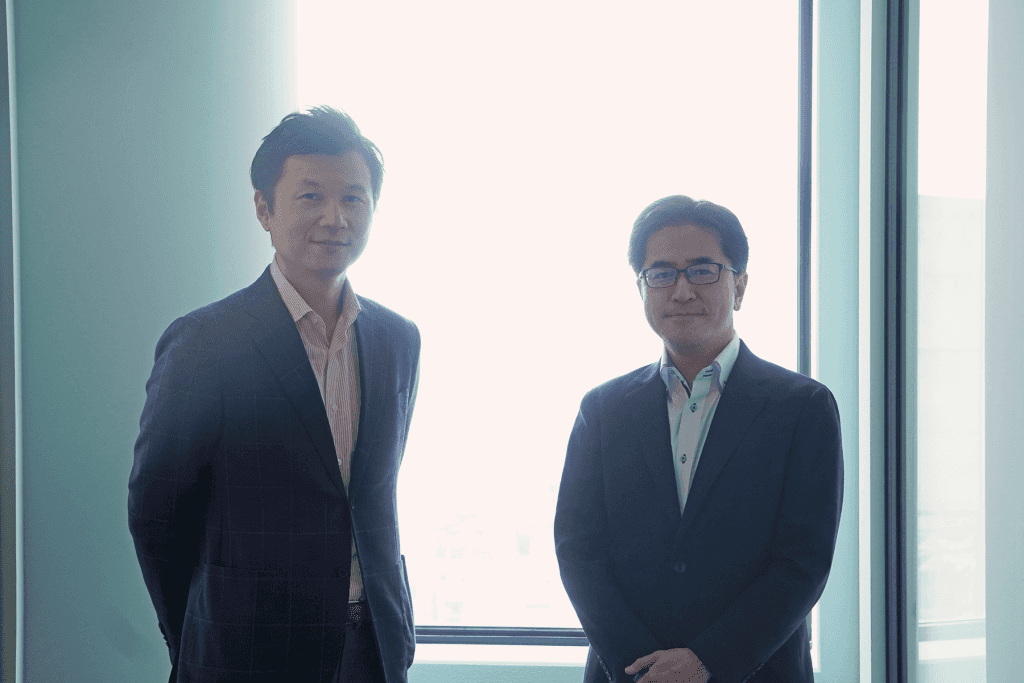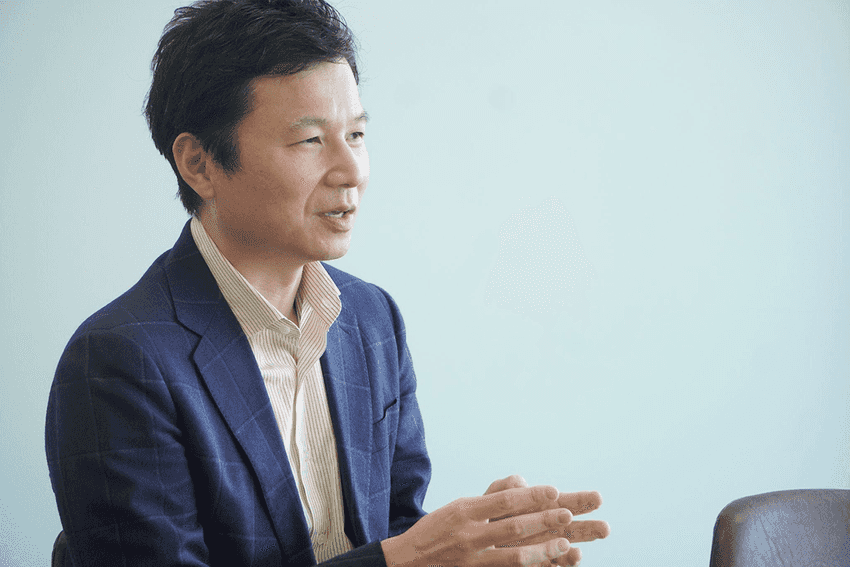※This article is a reprint of an interview published on Mercari’s owned media “mercan”.
Established in 2017, Mercari R4D (R4D) was created as a research and development organization that aims to implement its findings practically as part of the world at large. R4D stands for Research and 4 D’s: Development, Design, Deployment, and Disruption. Over the years, we have reached across the boundaries separating communities and applied various approaches in order to pioneer new value.
At the end of 2022, which marked five years since the establishment of R4D, we formulated our new mission, “Pioneering the path toward undiscovered value.” We are now in a phase of more ambitious challenges, seeking to become a hub that connects communities around the world and give back to society through our activities going forward.
In this series, we are looking at the past, present, and future of R4D over the course of three articles. In this third and final article, we spoke to Yoshihiro Kawahara, appointed as Head of Research at R4D in April 2022, and Masaya Mori, R4D Advisory Board member, about their vision and what they see as the ideal future for R4D.
R4D as a hub that fosters co-innovation between communities
──So, Yoshihiro, you were appointed as Head of Research in April of last year. It’s been a little over a year now, but how has it been?
Yoshihiro:It went by very quickly. Over the past year, I made a conscious effort to meet and communicate with as many people as I can. I think these conversations allowed me to discover things that I could not see from outside the company, and I feel that I now have a better understanding of the issues present at Mercari and where the company wants to head.
─And, Masaya, you have been supporting the growth of R4D as an Advisory Board member since April 2020. How do you think that R4D has changed over these three years?
Masaya: When I first started working with R4D in 2020, the organization was involved in a wide variety of research topics with the goal of implementing its findings out in society. I think these activities have become more refined over time and experience.
This is just my own personal theory, but I believe corporate R&D organizations go through three phases. The first phase is focused on increasing efficiency and productivity, the second is focused on providing value to customers, and the third is focused on creating new businesses and social value in collaboration with different individuals, companies, and organizations. The unique thing about R4D is that it started with the third phase right out the jump, and despite taking on this big challenge, it has been able to build a pretty solid ecosystem so far.
──Exactly how difficult is it to start with the third phase?
Masaya: Oh, I think there is a huge leap in difficulty between the second and third phases. That is, you can achieve the first and second phases on your own, working just within your company. However, in the third phase, you need to start working with external stakeholders, and if you want to get something done, you need to have everyone’s agreement first. You cannot succeed in this third phase with just your company alone.
Take the project Poimo, for instance, which was born from joint research between R4D and The University of Tokyo. In order to put Poimo out into the world, we needed the support and understanding of not just our partner companies, but local governments as well. When working with various people with different opinions like this, it is important to have a clear vision so that everyone is on the same page and working toward the same goal. R4D has a clear vision, and I think that is what allowed the organization to start from the third phase and succeed to grow into what it is now.
Yoshihiro: Ever since its founding, R4D has valued the principles of co-innovation in its research activities. The great thing for us has been that the issues that we are looking to solve are closely linked to society, and society as a whole holds a shared understanding of these issues. This means that we can conduct research with different communities, or work on identifying and defining these issues together. I don’t think this kind of co-innovation would have been possible if our research was instead focused more on ways to contribute to Mercari’s business or give it a competitive advantage.
Covering a wide range of subjects while thinking about the practical applications of our research
──Is there a specific project that comes to mind on the topic of co-innovation? If so, could you tell us a little bit about it?
Yoshihiro: Since 2020, Mercari has been publishing an annual Sustainability Report, where we give an overview of what kind of societal and environmental impact our business and corporate activities had that year. And, in last year’s 2022 report, we calculated and disclosed the company’s positive impact for the first time. These calculations were supervised by Moon Dami, a Project Researcher at The University of Tokyo’s Value Exchange Engineering Social Research Division, which is a joint research program between R4D and the University of Tokyo.
- Related article: Visions of a Circular Future— An Interview with Yoshihiro Kawahara and Shintaro Yamada on How Mercari Aims to Achieve “Planet Positive”
Mercari has always done things to contribute to achieving a circular economy, but there was never really any quantifiable evidence that showed whether or not these actions were actually making a positive impact. That is what made the 2022 report so meaningful—we were able to show our impact in numbers, which I think increases transparency and helps boost the trust people have in Mercari.
──What about you, Masaya? What are your thoughts on co-innovation?
Masaya: I definitely feel like we’ve made good progress, and we’ve been starting to see the results of our efforts. That’s why I personally would like to see R4D leap forward to the next step. For example, it is becoming increasingly challenging from a governance perspective for companies to share data with one another. I think it can be an exciting opportunity for R4D to take the lead in solving this issue, perhaps by acting as a hub and building a system to make this sort of data sharing easier. And, in order to continue implementing the findings of our research into society, we will need the active participation and engagement of the citizens in our society. Going forward, I think it will be necessary for us to come up with specific ways to further this participation.
Yoshihiro: I agree—as Masaya said, it will be key for R4D to establish a path to better enable us to implement our findings into society. Especially in the field of engineering research, it is common to conduct research with what we refer to in Japanese as a “seeds” approach, rather than a “needs” approach—we use our internal know-how and technologies (our “seeds”) to create new products/services and offer new value to our customers, rather than creating products/services based on the customer’s needs. Since we are not responding to defined needs, we must constantly be thinking about what issues we are solving for who and identifying the potential risks while going about our research.
Masaya: To give an example of establishing this path for ourselves, there was an open workshop for residents at Kashiwa-no-Ha Smart City in Chiba when they first started installing AI cameras in their area. I was also involved in this workshop, but I remember the event organizers expecting most of the feedback to be negative regarding the introduction of these cameras. However, to everyone’s surprise, that was not the case.
After listening to both the pros and cons at the workshop, the participants supported the idea of introducing AI cameras for security purposes, as long as the business operating the cameras promised to give a proper explanation on how they work. In this way, if we can get the general public in agreement with what we are doing, it will be easier to implement our research and technologies out in the world, and it will open up more possibilities for us.
Yoshihiro: Yes, whenever introducing a new technology, it’s very important to provide thorough explanations and do what is necessary for people on the receiving end to understand and be happy with the decision. Exciting, breakthrough technologies can appear out of nowhere, but we must also keep in mind how technology can do harm when used in violation of ethical and legal standards. It’s just as important to prepare for these potential risks and prevent these new technologies from being abused.
On a related note, in 2021, R4D worked with Osaka University’s Research Center on Ethical, Legal and Social Issues (ELSI Center) to publish a set of Ethical R&D Guidelines. These guidelines were created to promote the practical applications of our research more responsibly, while giving due consideration to social risk and impact. The Ethical R&D Guidelines will provide a clearer picture of what we need to do or what we are still lacking before implementing our findings in society, and I think they will be a strong foundation for the future of our R&D activities.
Expectations for the new mission of “Pioneering the path toward undiscovered value”
──Last year, R4D formulated its new mission of “Pioneering the path toward undiscovered value.” How do you think this new mission will impact R4D?
Yoshihiro: Research is a slow and steady process, where we take a set of small actions each day, and these small actions build up over time to ultimately lead to results. So considering the nature of the work, I don’t expect there to suddenly be any major changes in what we do on a daily basis, just because there is a new mission. However, I will say that now that we are aiming to search for “undiscovered value,” I think we will be able to be more creative with our use cases, since this vision is not something that is just based on numbers. I think “undiscovered value” can inspire researchers to think in new ways and come up with new, groundbreaking ideas. In that sense, I’m looking forward to seeing what innovations this new mission will bring.
Masaya: Indeed, it’s very important to have proactive discussions about use cases. When developing cutting-edge technologies, it is necessary to have a clear vision of what you want to do with that technology. Without a clear vision, it will be hard to get other companies on board, and it will not be possible to implement the technology into society.
However, the thing about R&D organizations of private companies is that there is a fear of failure. Because of this fear of failure, these organizations sometimes end up making the use cases of their technologies too specific and thereby limiting themselves. Let’s say an organization is looking to make better use of R&D for their own business. This organization will likely start coming up with more concrete and realistic use cases for their technology, but this tends to make the technology more predictable and less appealing to investors. In order to avoid this from happening, what we can do is come up with some other use cases with a wider, bird’s eye view, in addition to these specific use cases. Then, we can “cluster” similar use cases into groups, and go through each of the different groups to consider the overall impact of the technology. I try to take into account both the zoomed-in and zoomed-out perspective using this method. That way, executives will be able to make informed decisions with a good understanding of the technology’s cost effectiveness.
What impresses me about R4D is that everyone is constantly looking beyond these possibilities, with no fear of failure. What kind of use cases can “[pioneer] the path toward undiscovered value”? I think this new mission can bring about an impact that our community has not seen before.
──Lastly, do you think Mercari R4D may be able to contribute something to the field of R&D in Japan? If so, what do you think that contribution is?
Yoshihiro: Currently, in Japan, it is hard to get funding for research born from bottom-up innovation, even at universities. That’s why it is so important for private companies to proactively invest in research for the future. However, as Masaya mentioned, over the past 20 years or so, it has been more and more common for companies to invest only in technologies with realistic use cases. Of course, it is important to have a clear plan for how the technology will be used in order to reassure stakeholders. At the same time, though, I think there is also great value in taking a certain level of risk to find value that has not yet been discovered. Unless this mindset becomes more prevalent, I am afraid R&D in Japan will not be able to evolve. I would like R4D to continue taking on bold challenges to spread this mindset in Japan.
Masaya: R4D is special, because there are very few companies in Japan that can invest in this “undiscovered value.” I hope R4D can lead by example and tackle new and exciting areas of research without fearing failure. By doing so, I think more organizations will start to follow, and it will definitely have a positive impact on R&D in Japan.



